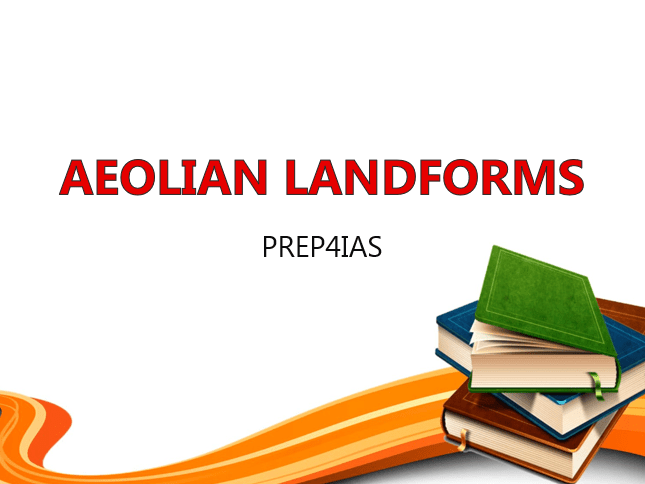In this section, we will cover 30 Useful Questions on Aeolian Landforms for UPSC /PSC/SSC Exams. Aeolian Landforms are landforms which are created by air or wind activity. It could be either depositional or erosional Landforms. Depositional Landforms mainly includes Dunes, Ripple Marks, Loess, Desert Pavement, Desert Vanish etc. Similarly, Erosional Landforms includes Ventifacts, Deflation Basin, Mushroom rocks, Lag Deposit and so on. Here we will see important questions from Aeolian Landforms which can be asked in your various competitive exams.

Aeolian Landforms
1. What is ergs ?
Ans. Deserts having mobile sands are called ergs.
2. Where is the largest erg of the World ?
Ans. Rub-al-khali
3. Where is Qattara Depression located ?
Ans. Western Part of Egypt
4. What is Loess ?
Ans. It is wind-blown deposit of fine silt and dust.
5. What is the Rainfall criteria for an area to become Semi-Arid Region ?
Ans. 25-50 cm of rainfall
6. What are the different types of Deserts ?
Ans. Below are the different types of deserts :-
a)Erg or Koum
b)Stony Desert
c)Rock Desert
d)Desert Plateau
e)Rock Peak Deserts
f)Intermont Basins
7. What is responsible for yellow colour of Hwang Ho ?
Ans. The Loess of china gets eroded by running water and suspended in Hwang Ho to form yellow colour.
8. What are the different sources of Loess ?
Ans. There are two different sources:-
a)Weathered material in Deserts
b)Very fine powder from regions of Glacial outwash
9. Where is the largest known deposit of Loess located ?
Ans. China
10. What is Reg ?
Ans. Stony Desert in Algeria is known as Reg.
11. What is Serir ?
Ans. Stony Desert in Libya and Egypt is known as Serir.
12. What is Sandy Desert called in Turkmenistan ?
Ans. Koum
13. Who postulated the theoretical Cycle of Arid Erosion ?
Ans. W.M Davis
14. What is Ravine ?
Ans. A deep narrow gauge formed by running water having size smaller than Canyon.
15. What is Bahada ?
Ans. A gentle slope running down from mountain to an internal basin.
16. Which is the Famous Playa in Tarim Basin ?
Ans. Lake Lap-Nor
17. Which are the aeolian landforms usually forms due to Fluvial Action in Desert ?
Ans. Badland, Pediments, Bajada and Playas.
18. What is Seif ?
Ans. A longitudinal Sand dune shape like a sword.
19. Where is the biggest Yardang of the world located ?
Ans. Lut-Desert in Iran
20. What are dunes ?
Ans. Dunes are large pile of depositional landforms formed mainly from blowing wind over a period of time.
21. Which type of Dunes are mainly formed from Wind Activities ?
Ans. Sand and Snow Dunes
22. What is Barchan Dune ?
Ans. It a dune formed from low sediment supply in the regions where wind blows in one primary direction. More on Aeolian Landforms.
23. What are Ripple Marks ?
Ans. These are small ridges of sediments that formed due to blowing of wind or water over loose sediments in either a current or wave pattern.
24. Give an example of Ripple Marks Landforms ?
Ans. Wind ripples on aragonite sand from San Salvador Island in the Bahamas.
25. What is Desert Varnish ?
Ans. It is yellow-black coating of clay formed over the desert rock due to transportation of winds. Yellow color is mainly due to the formation of Iron oxides and black color is mainly due to the formation of Manganese oxides.
26. Give an example of Desert Varnish ?
Ans. Desert varnish in Valley of Fire State Park.
27. What is the another name of Desert Pavement in Australia ?
Ans. Gibbers or Gibber Plains
28. Can a Varnish forms on a Limestone ?
Ans. No
29. Why a Varnish cannot form on a Limestone Rock ?
Ans. It is because limestone is too water soluble and hence does not provide a stable surface for varnish to form.
30. Where does Loess tend to develop ?
Ans. It tends to develop in very rich and productive soils.
